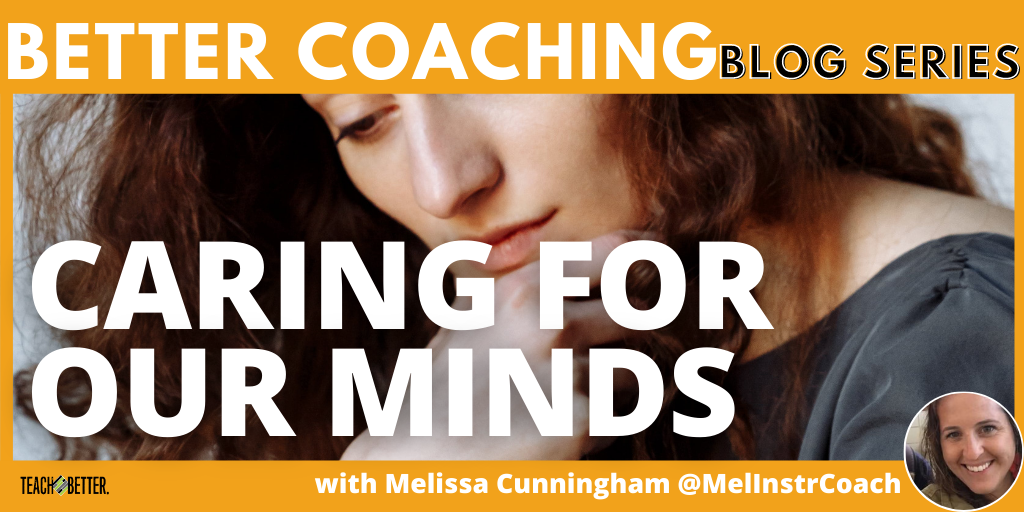TL;DR:
- Why don’t we talk more about self-care that can occur during the work day?
- The goal of meditation is not to take a mindful minute each day, but to eventually be able to find mindful moments in every part of the day.
- Have students use a tool like a T-chart to focus on what I CAN control vs. what I CAN’T control.
- Think about setting a bell or timer in your classroom every 5 to 15 minutes. Teach students to be present in the moment. It’ll help students become stronger learners.
- Work with students to build up a repertoire of strategies that can help alleviate feelings of stress or anxiety. Connect your breath with movement.
Caring for Our Minds
With constant changes, numerous demands, and lots of stress, this year has been something for the books, to say the least. If your district is like mine, we’ve had four different starts to the school year, four schedule changes, and countless changes to how we teach. We are hearing from our administrators, our professional network, and our friends and families to take a break, take time for yourself, step away from your computer. But Sunday rolls around, anxiety sets in, and the stresses of the week come at us again.
Don’t get me wrong. Self-care is ridiculously important, and statements such as these are all well-intentioned. Also, there have been countless articles and blogs about how to take care of yourself, step away, and more. But, we spend so much of our lives either at work or doing work. We spend more time with our colleagues sometimes than we do with our own family and friends.
Yet, we’re always counting down the minutes for down time and time to relax. Again, we absolutely need to step away. We need to unwind. We need to spend time doing non-work related things and we need to spend time with people other than our co-workers. But, I’ve been wondering lately why we don’t talk more about self-care that can occur during the work day.
In my role as an instructional coach, I sometimes feel like a social worker just as much as a coach. Just like with students, adults can’t learn when they are not in the right headspace or haven’t had their emotional needs met. When we are stressed, anxious, or frustrated, we aren’t ready to learn or try something new. It’s vital in my role to listen to teachers, talk through frustrations, and just be there. But with so many stresses this year, how do we get in the right headspace? How do we control what’s within our control?
If we can find ways to recognize the pattern of our thoughts and feelings, we can give our students an amazing gift: to find peace even in the most stressful moments. Click To Tweet
Caring for Our Minds: Mindfulness and Meditation
Mindfulness and meditation are not new ideas. Many of us have learned about their importance in the classroom. I find many teachers implementing mindful minutes into the classroom. We may start class with some mindful breathing, or possibly end class with a mindful minute. But what about the rest of class time? What about the rest of the school day?
If you read anything on mindfulness and meditation from the experts in the field from Thich Nhat Hanh to Jon Kabat-Zinn, the goal of meditation is not to take a mindful minute each day but to eventually be able to find mindful moments in every part of the day. This takes time. Being in the present moment does not come naturally. It takes constant practice.
Additionally, the goal of mindfulness and meditation is not to get rid of our thoughts and feelings—this is nearly impossible—but to understand whether they are perceived as negative or positive. It’s to recognize the thoughts and feelings that occur and learn how to not attach emotions and negative thoughts to these.
So, what does this mean for us in our schools and classrooms? I’m stating the obvious here. It does not feel good to be stressed or frustrated or anxious. But, instead of finding ways to either avoid or flee negative feelings, thoughts, and emotions, let’s learn to lean into those negative thoughts and feelings and get curious about them.
Below, I want to share some strategies that you’ll find benefit both you and your students. I think by finding ways to model and practice care for our own minds, we can also help our students. If we can find ways to recognize the pattern of our thoughts and feelings, we can give our students an amazing gift: to find peace even in the most stressful moments. But also how to lead a more peaceful and happier life in general.
Caring for Our Minds: What I CAN Control vs. What I CAN’T Control
This is a phrase that I would venture to say we have heard a lot, but what does it actually mean? A few summers ago, I found myself quitting a very stressful assistant principal job to become an instructional coach. I should have been relieved, yet I found myself full of anxiety like I never had before.
I started suffering from insomnia, and I woke every day with all consuming anxiety that I just couldn’t seem to get rid of. This forced me to start reading more about anxiety and how I could care better for myself, which led into my first experiences with meditation.
One strategy that I still use today is surrounding the idea of control. As I struggled with insomnia, I realized that I didn’t really have any control over whether I slept or not. It was beyond my control no matter how hard I wanted to control it.
But, what was in my control was what I did during the day. I could exercise to relieve stress. Meditate. Eat healthier meals. Or I could journal to recognize my negative thoughts. This small task of jotting down what was in my control and what was not brought me such peace.
Instead of starting with a mindful minute, think about having students start class a few times a week by making a T-chart. What are things that are within my control today? And what is not in my control? I might not be able to control my behavior today because I am so upset about a fight I got into with my best friend, but what I can control is my breathing, because that helps me calm down.
I can’t control right now that I am in math class and it is hard for me. But I can ask for help from my friend when I’m struggling. Not only does this strategy help kids start to recognize what is in their control and what’s not, but it also starts helping them develop strategies to deal with situations that occur.
This tool is a great way to give students time and space to talk about what’s on their minds and build strategies as a class for when we are feeling stressed or anxious.
Caring for Our Minds: Mindful Moments
At Thich Nhat Hanh’s Plum Village in France, which is a Buddhist monastery, they have a bell that goes off every 5 minutes. When this occurs, everyone stops what they’re doing to come back to the present moment. Everyone stops talking or moving. They focus on becoming aware again of the present moment including what’s on their minds. They think about what’s going on around them and coming back in tune with their emotions and thoughts.
We know that there is limited time with our students. We have so much to teach and so little time, but we also know that if we and our students are not in the right headspace to learn, all that learning doesn’t matter anyway. Think about how many times a day this happens to us.
When we are driving to and from work or when we are doing the dishes, how many of us actually stop to be present during these moments? How many of our minds are completely elsewhere? Then, think about how often this happens in the classroom for us and our students.
Think about setting a bell or timer in your classroom. The time does not matter. It could be anywhere from every 5 minutes to every 15 minutes. But the point is we can teach our students to be present in the moment. It’s not only going to help students become stronger learners, but it will infiltrate other moments in their lives.
[scroll down to keep reading]
Caring for Our Minds: Mindful Movements
One of the best pieces of advice I got while I was suffering from insomnia was that I couldn’t “think” my way out of it. Thinking about it actually caused more anxiety and stress. There wasn’t a way to problem-solve through this one. I had to learn to manage my stress and anxiety better. And to do so, I needed to actually care more for my body than my mind.
The sympathetic nervous system is in many ways responsible for our reaction to stress and/or anxiety. You know the feeling. Your heart starts to race, your palms start to sweat, you start to feel butterflies in your stomach, or you feel pain in your head. Instead of sitting in those feelings and perseverating in them, work with students to build up a repertoire of strategies that can help alleviate some of these feelings.
Any time we can connect our breath with movement, we can work to calm our sympathetic nervous system. Try taking 3 deep breaths followed by 3 jumping jacks. Repeat as many times as needed. Take a walk around the room focusing on deep breaths as you move.
Do some yoga and stretching moves while focusing on the breath. Lastly, if you’re interested in more ideas, take a look into EFT tapping. Tapping is similar to acupuncture. But instead of the use of needles, we use our fingers to tap different points on the body to help calm anxiety.
Overall, by modeling mindfulness and meditation strategies for our students, we are helping students and ourselves. If we are always trying to avoid stressful and hard situations, we are going to spend our lives running away from every negative moment. Life is full of stress and hurt. It’s unavoidable. As Thich Nhat Hanh says, “The seed of suffering in you may be strong, but don’t wait until you have no more suffering before allowing yourself to be happy. When you learn how to suffer, you suffer much less.”
ABOUT MELISSA CUNNINGHAM
Melissa Cunningham is a passionate middle school educator who has had the pleasure of being in the middle school setting for all 12 years of her career. Her roles span from language arts and math teacher to assistant principal and now, instructional coach. She is especially passionate about student leadership and choice in the classroom while cultivating the skills of collaboration, problem-solving, and creativity. Outside of school, she enjoys photography, writing, reading, hiking, and spending time with my husband, friends, and family.



